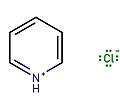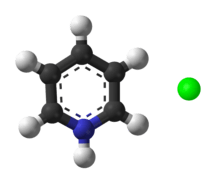Pyridinium chloride
Pyridinium chloride is an organic chemical compound with a formula of C5H5NHCl.
 The chemical structure of pyridinium chloride | |
 | |
| Names | |
|---|---|
| IUPAC name
Pyridinium chloride | |
| Other names
Pyridine hydrochloride | |
| Identifiers | |
3D model (JSmol) |
|
| ECHA InfoCard | 100.010.026 |
| EC Number |
|
PubChem CID |
|
| UNII | |
CompTox Dashboard (EPA) |
|
| |
| |
| Properties | |
| C5H6NCl | |
| Molar mass | 115.56 g/mol |
| Appearance | Hygroscopic white crystals |
| Density | 1.34 g/cm3 |
| Melting point | 144 °C (291 °F; 417 K) |
| Boiling point | Decomposes |
| 85 g / 100 mL | |
| Solubility | Soluble in chloroform, ethanol, insoluble in diethyl ether |
| Vapor pressure | 1 (0 °C) |
| Acidity (pKa) | 5 |
| Hazards | |
| Main hazards | Irritant |
| Safety data sheet | |
| GHS pictograms |  |
| GHS Signal word | Warning |
GHS hazard statements |
H302, H312, H315, H319, H332, H335 |
| P261, P264, P270, P271, P280, P301+312, P302+352, P304+312, P304+340, P305+351+338, P312, P321, P330, P332+313, P337+313, P362, P403+233, P405, P501 | |
| NFPA 704 (fire diamond) | |
| Flash point | Non-flammable |
| Non-flammable | |
| Lethal dose or concentration (LD, LC): | |
LD50 (median dose) |
1600 mg/kg (oral, rat) |
Except where otherwise noted, data are given for materials in their standard state (at 25 °C [77 °F], 100 kPa). | |
| Infobox references | |
Preparation
Pyridinium chloride can be produced by passing hydrogen chloride in pyridine dissolved in diethyl ether. The chemical formula is as follows:
Acidity
Containing a pyridinium ion, pyridinium chloride has a pKa of approximately 5, slightly more acidic than that of typical amines. This is due to the hybridization of the nitrogen: the nitrogen is sp2 hybridized and more electronegative than those nitrogens in ammonium cations, which are sp3 hybridized. Hence they are stronger acids than amines and can be more easily deprotonated by bases.[3]
gollark: You said scala was good.
gollark: Also, yes, I agree with `-` here.
gollark: ~~You can do it via crazy, crazy indirection~~
gollark: RUSt.
gollark: ruST.
References
- "Pyridine hydrochloride(628-13-7) MSDS Melting Point Boiling Point Density Storage Transport". ChemicalBook. Retrieved 2019-03-22.
- Wilson, Michael W. (2001). "Pyridinium Chloride". Encyclopedia of Reagents for Organic Synthesis. John Wiley & Sons. doi:10.1002/047084289x.rp287m. ISBN 9780470842898.
- "Pyridine: synthesis and reactivity | BrainyResort". Brainy Resort. 2016-11-08. Retrieved 2019-03-28.
This article is issued from Wikipedia. The text is licensed under Creative Commons - Attribution - Sharealike. Additional terms may apply for the media files.
